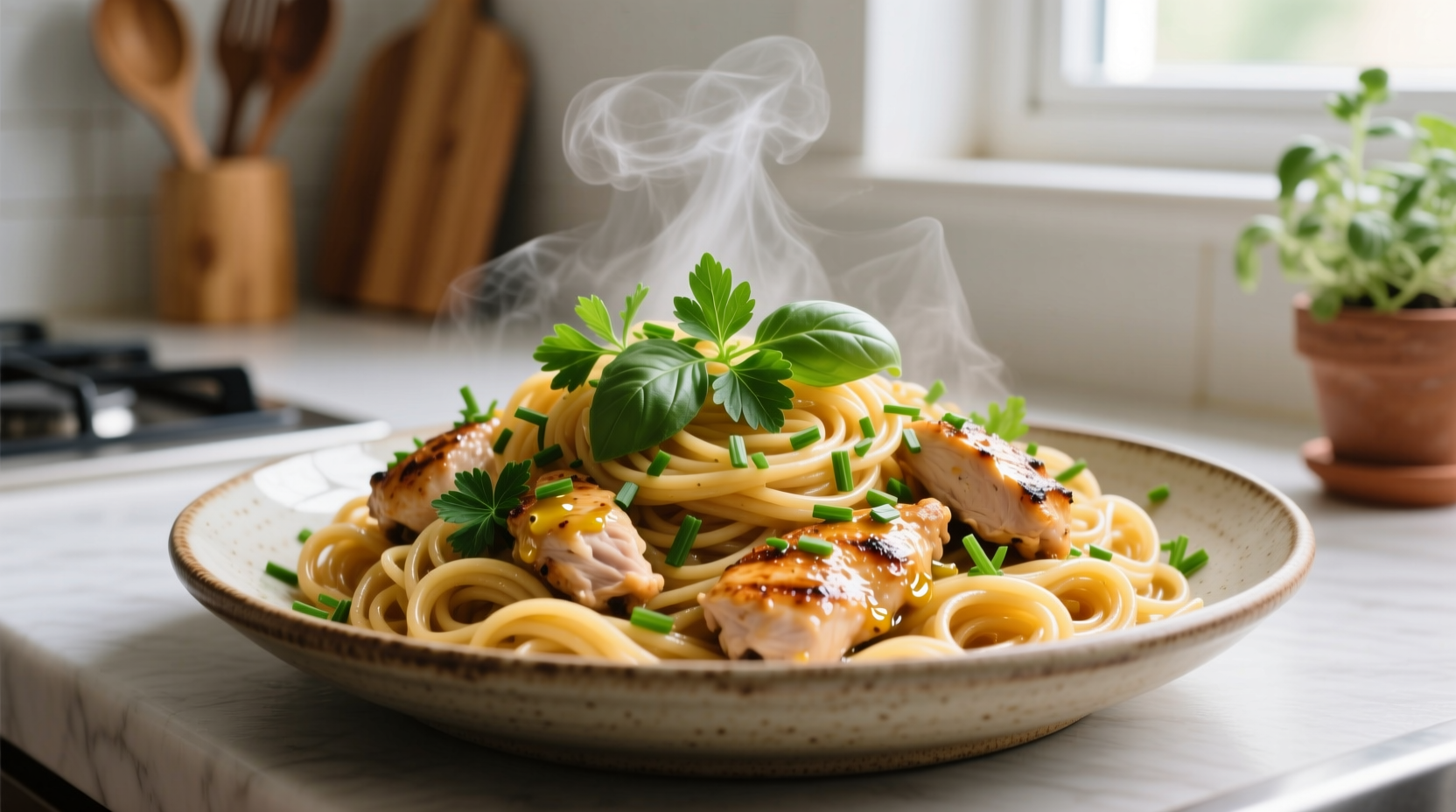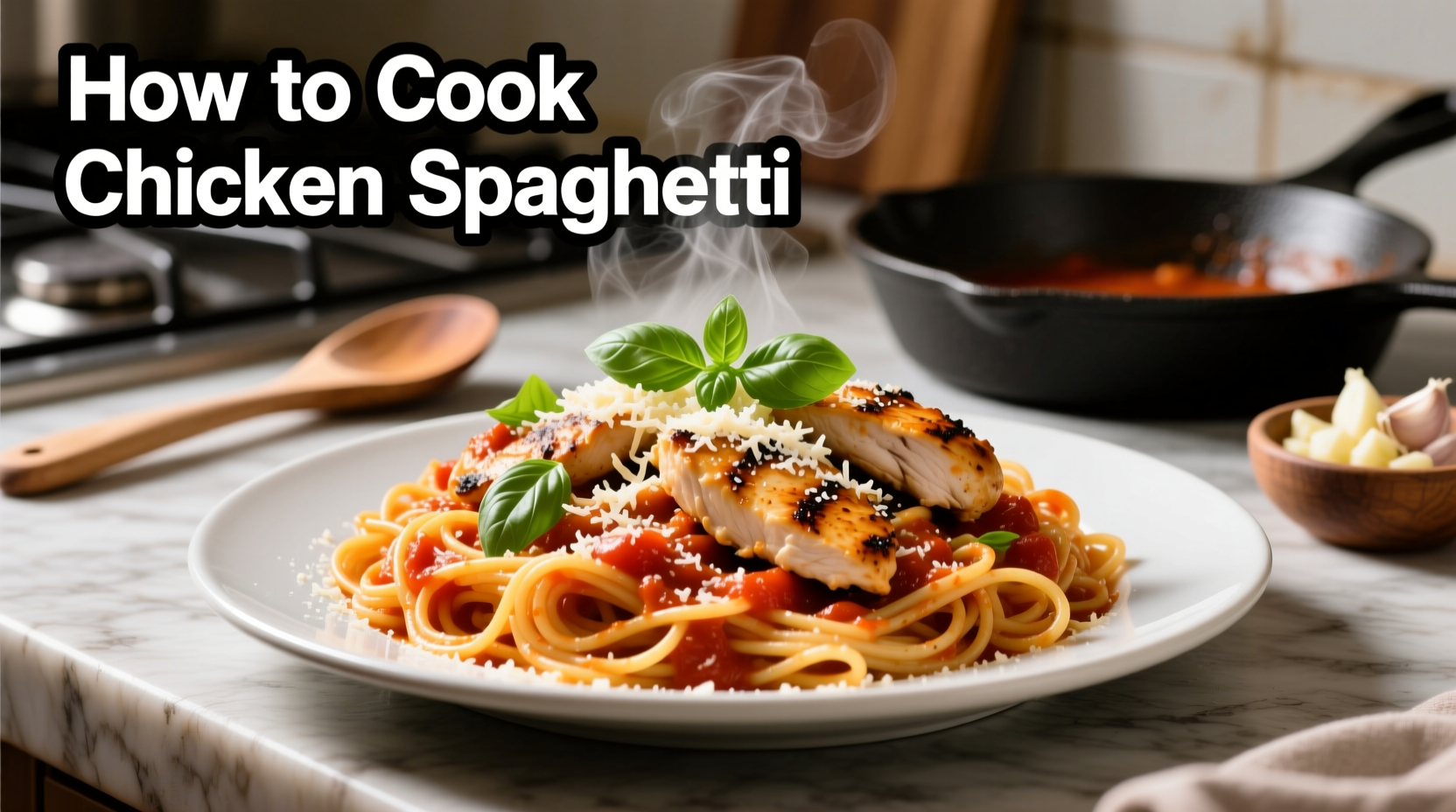Craving a satisfying dinner that combines tender chicken with perfectly cooked spaghetti? You'll master this classic comfort food in record time with our step-by-step guide. Forget bland, overcooked versions—we'll show you how to achieve restaurant-quality results at home with professional chef techniques that guarantee juicy chicken, perfectly textured pasta, and a sauce that clings just right. Whether you're cooking for family weeknight dinners or impressing guests, this approach delivers consistent, delicious results every time.
What You'll Need Before Starting
Gather these essentials before firing up your stove. Having everything prepped streamlines the cooking process and prevents last-minute scrambling.
| Category | Essential Items |
|---|---|
| Equipment | Large pot, skillet or sauté pan, colander, meat thermometer, tongs, wooden spoon |
| Ingredients | 8 oz spaghetti, 1 lb boneless chicken breast, 2 cups sauce base (tomato or cream), 3 garlic cloves, 2 tbsp olive oil, salt, pepper, fresh herbs |
| Prep Time | 10 minutes (chopping, measuring, organizing) |
Pro tip: Always measure ingredients before starting—known as mise en place in professional kitchens. This French culinary principle ensures smooth execution and reduces stress during cooking. For optimal pasta texture, use a 1-2% salt solution in your cooking water (roughly 1-2 tablespoons per gallon), which properly seasons the pasta throughout rather than just on the surface.

Step-by-Step Cooking Process
Follow this sequence for perfect results every time. The timing is calibrated to have all components ready simultaneously.
1. Perfect Pasta Every Time
Bring 4 quarts of well-salted water to a rolling boil. Add spaghetti and cook for 8-10 minutes or until al dente—tender with slight resistance when bitten. Reserve 1 cup of starchy pasta water before draining. This water contains valuable starch that helps emulsify your sauce later. Professional chefs rely on this technique to create restaurant-quality sauces that cling perfectly to pasta.
2. Cooking Chicken to Perfection
While pasta cooks, season chicken with salt and pepper. Heat olive oil in a skillet over medium-high heat. Cook chicken 5-7 minutes per side until reaching 165°F internal temperature—the USDA-recommended safe temperature for poultry. Rest for 5 minutes before slicing. This resting period allows juices to redistribute, preventing dry chicken. According to food safety guidelines from the USDA Food Safety and Inspection Service, undercooked chicken poses serious health risks, making accurate temperature monitoring essential.
3. Building Flavorful Sauce
In the same skillet, reduce heat to medium. Add minced garlic and sauté for 1 minute until fragrant but not browned. Choose your sauce base:
- Tomato version: Add 2 cups marinara sauce, simmer 5 minutes
- Cream version: Add 1 cup heavy cream and 1 cup chicken broth, simmer until slightly thickened
Finishing Touches for Restaurant-Quality Results
Combine all elements for a cohesive dish that balances textures and flavors.
Combining Components
Add drained spaghetti directly to the sauce in the skillet. Toss gently with tongs for 2 minutes over low heat, allowing pasta to absorb flavors. Add sliced chicken during the last minute. This critical step ensures the sauce adheres properly to the pasta rather than sitting separately on your plate.
Serving and Storage Tips
Serve immediately with fresh basil or parsley. For leftovers, store in an airtight container for up to 3 days. Reheat gently with a splash of water to restore moisture. Professional kitchens follow strict food safety protocols that recommend consuming cooked chicken within 3-4 days to prevent bacterial growth.
Troubleshooting Common Issues
Even experienced cooks encounter challenges. Here's how to handle them:
Dry Chicken Solutions
If your chicken tends to dry out, try these professional techniques:
- Pound thicker pieces to even 1-inch thickness for uniform cooking
- Brine in 1/4 cup salt dissolved in 4 cups water for 30 minutes before cooking
- Cook to 160°F then remove from heat—residual heat will bring it to safe 165°F
Sauce Consistency Problems
Adjust your sauce texture with these solutions:
- Too thin: Simmer longer or add a cornstarch slurry (1 tsp cornstarch + 1 tbsp cold water)
- Too thick: Gradually add reserved pasta water or chicken broth
- Separating: Reduce heat and whisk vigorously while adding cold butter, one tablespoon at a time
Variations to Suit Your Taste
Once you've mastered the basics, experiment with these chef-approved variations:
Regional Italian Inspiration
While chicken spaghetti isn't traditional Italian fare (chicken was rarely paired with spaghetti in historical Italian cuisine), you can create authentic regional variations:
- Northern Italy: Cream-based sauce with mushrooms and white wine
- Southern Italy: Tomato-based with olives, capers, and red pepper flakes
- Coastal regions: Light lemon-garlic sauce with cherry tomatoes
Health-Conscious Options
Modify the recipe for dietary needs without sacrificing flavor:
- Use whole wheat or legume-based spaghetti for added fiber
- Substitute half the cream with pureed cauliflower for lower calories
- Add spinach or zucchini ribbons during the last minute of cooking











 浙公网安备
33010002000092号
浙公网安备
33010002000092号 浙B2-20120091-4
浙B2-20120091-4